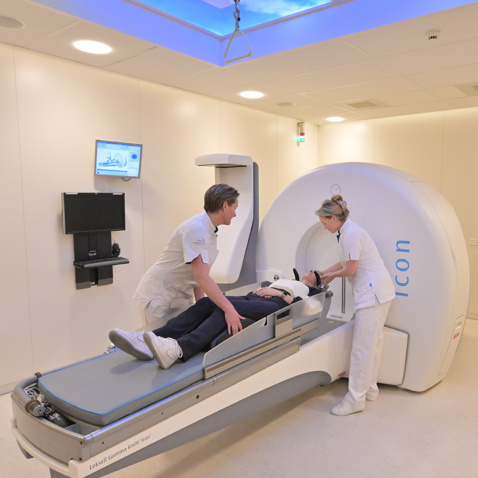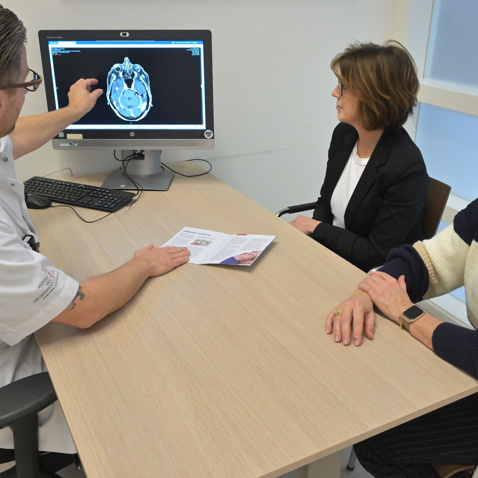Gamma Knife: treatment with mask
Has your practitioner opted for treatment with a mask? Then the lab technician makes a mask that fits your face exactly. This mask is made of plastic material with holes in it. This allows you to breathe easily and hear everything.
While making the mask, it is important that you remain still. The mask ensures that your head does not move during radiation.
The treatment
What can you expect with a Gamma Knife treatment with a mask? Click on the steps below to read more.
Fitting the mask
A lab technician will pick you up to measure the mask. You lie on your back on the radiation table with your head in a pillow. The mask material is heated in a container of warm water until it is malleable. It is then placed over the face.
The mask is clipped to the table. The lab technicians form the mask. They gently press it around the nose and under the chin. You can hear everything and you can breathe through the nose. After about 5 minutes, the mask has cooled and hardened and the mask is unclipped.
During the curing of the mask, a Gamma knife CT scan is made. This scan is made to determine your posture during the radiation. It is important that you stay still.
The radiation
A lab technician will pick you up for the radiation. You lie on your back on the radiation table. You get an alarm bell in your hand. Before the treatment, the lab technicians test whether it works. If there is anything, you can press the alarm bell.
The lab technicians also place a marker on your nose. With this marker we can follow your movement with a camera. It is important that you remain still during the radiation. Do you move too much during the radiation? Then the device will automatically pause. This may cause the treatment to take a little longer.
If you are in a good position, the lab technicians leave the radiation room and the radiation starts. The lab technicians keep a close eye on you via the cameras. The lab technicians will keep you informed via the intercom.
Side effects
Due to its high accuracy, irradiation with the Gamma Knife has a small chance of side effects. Below you can read about the most common side effects.
In the first days or weeks, usually temporarily:
- Fatigue
You may feel fatigued. This can be due to your treatment and your condition, but also regularly traveling to the hospital can be an extra burden. The fatigue may persist after the treatment. - Complaints due to swelling (oedema), for example headache and nausea.
Sometimes a temporary spot of fluid (edema) can develop from or around the tumor within a few days after treatment. This can cause headaches, nausea or vomiting. Neurological deficits in the head or brain or an epileptic seizure are an exception. To prevent this, the practitioner sometimes prescribes dexamethasone for a few days to counteract the swelling. These complaints can also occur weeks to months after the radiation. You must then contact your practitioner immediately on 020 512 9111. In emergencies, we are available 24 hours a day.
After a few months:
- Radiation necrosis
After a few months to years, you may experience a radiation reaction. The chance of this is small. Radiation necrosis is an inflammation that occurs during the removal of the tumor cells. You may experience headaches, nausea, loss of function or seizures. This can be treated well with medication. Very occasionally surgery is necessary. - Hair loss
The risk of hair loss is minimal and only happens if the tumor is close to the skull. Your radiation oncologist will tell you about this if this applies to you. - Memory loss or dementia
Memory loss or dementia due to radiation hardly ever happens. If this applies to you, the radiation oncologist will tell you.
Aftercare and check-up
At the end of your radiation treatment, you will remain under control for a while. If you have any questions about side effects, medication or the periodic MRI scan, you can always reach us on 020 512 9111. Then ask for the Radiotherapy department.




 nl
nl